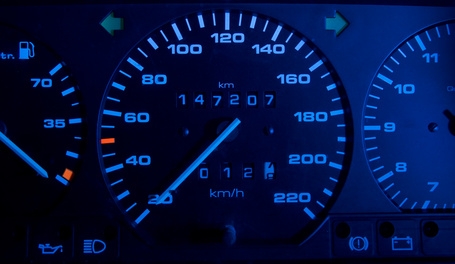
Most modern car dashboards only have the basic gauges, which are tachometer, speedometer and fuel level. In an effort to streamline the dashboard, automotive designers have eliminated the ammeter, the water temperature gauge and the oil gauge. These were replaced by warning lights, commonly called "idiot lights." Consumers became dissatisfied with this, wishing to read gauges instead to warn them earlier of impending problems. Manufacturers are now bringing back gauges, which includes the oil gauge. Knowing how to read an oil gauge correctly could save your engine, since you'll be able to catch a problem early--and correct it--before the engine self-destructs.
The function of an oil gauge is to provide you with a visual readout of the oil pressure inside the engine. It has an indicator needle and a readout scale. The numbered scale (usually given in PSI) usually has a green area, and some red areas painted on the scale. A pressure sensor inside the engine sends information to the oil gauge, and the needle moves accordingly.

The oil gauge is a significant part of an overall engine diagnostic system. All engines need oil to function properly. The internal oil pump builds up pressure, and circulates the oil through internal passages to critical components like bearings and connecting rods.Without oil, components will overheat and seize, and the end effect is the engine self-destructs. The oil gauge gives the driver a visual indication of the health of the lubrication system by displaying engine oil pressure.
There are two basic types of oil gauges--electronic and mechanical. Both have sensors mounted in the engine. The electronic type of sensor sends out an electrical signal to the gauge, which then interprets this signal as movement of the needle. The mechanical of type sensor has a small tube attached to it, and it sends out oil directly to the oil gauge. The gauge then interprets this pressure into movement of the needle. Some newer gauges today are digital and have a readout instead of a needle. All three types are efficient and reliable.
As you are driving, briefly glance at the gauge from time to time. The needle should always be inside the green area. If the needle starts to move inside one of the red areas, immediately pull off the road and shut the engine down. Not doing so could destroy your engine. One of several things may be occurring. The easiest thing to do is check the oil level, and add oil if low. If there is enough oil, then the problem is serious and should be referred to a qualified mechanic for repair.
There are many aftermarket gauges readily available, such as those distbuted by egauges. Installing gauges is a complicated and laborious procedure, and is best referred to a qualified technician who is familiar with gauge installation.
Having only warning lights in a dashboard does not prevent problems; warning lights only flash when a problem has reached the severe level. The best alternative is to have all three gauges: ammeter, water temperature and oil pressure. By glancing at all three briefly from time to time while driving, you can foretell a problem if the needles start to move toward the red. By shutting down the engine before the needles enter into the red zone, you are preventing the engine from destruction.